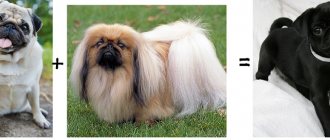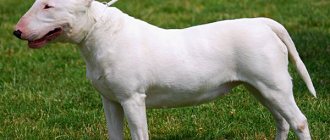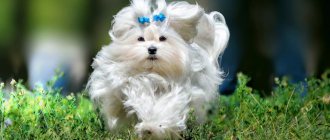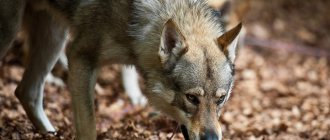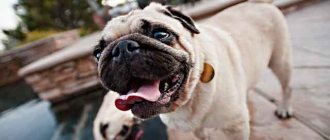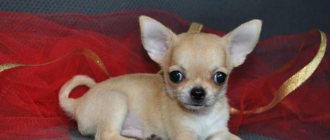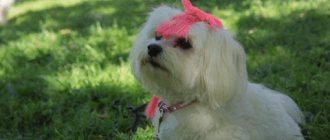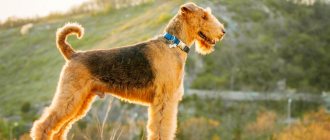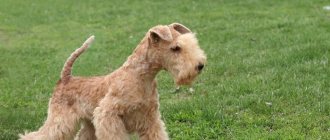Terriers are considered one of the largest groups in terms of the number of representatives among breeds. There are more than 30 varieties, which are divided into 4 main subgroups. Among them are hunting, decorative and service dogs. Different sizes of dogs allow you to choose a pet to suit your goals. Dog handlers distinguish terriers by size, coat length, and main purpose. When choosing a dog, you need to focus on the main characteristics of the breed and know the behavioral characteristics of a real hunter.
Origin story
The name of the group comes from the Latin word terra - "earth". Translated from French into Russian, the designation terrier is represented as “den, hole.” Initially, the breeds were bred by selective breeding to select the best hunting qualities for burrow hunting. The most popular trophies were foxes, badgers, and raccoons.
Some of the breeds were not subjected to selection, which made it possible to maintain authenticity and typical qualities. Among terriers there are those who have excellent watchdog qualities. Since ancient times, they have been used as guards for warehouses and storehouses.
Most terriers got their name from the area where they appeared. Known since the end of the Middle Ages, many breeds developed during the era of hunting fashion. These are several periods: from welded to gun, burrow. The gradual disappearance of wild animal prey in European forests and mountains led to a reduction in hunting breeds and the emergence of a service direction. Some breeds are on the verge of extinction. The reason for this was the world wars that took place in Europe in the 20th century. Restoration work is being carried out to revive the population of rare, endemic dogs.
As artificial selection progressed, the size decreased and adapted to the main task - searching for prey underground. It is the diversity of terriers that attracts lovers of this group. There are rare breeds that are distinguished by their sophistication and elegance. The large number is explained by the fashion for this or that dog. This does not always carry positive traits. For the sake of quantity, closely related crossings occur, which leads to the appearance of genetic defects and a decrease in natural immunity.
Character
This breed of dog is distinguished by truly human quarrelsomeness and a love of argument and bickering. The bad temper of these little dogs does not depend on their upbringing or age. Both in childhood and in old age, they are equally prone to hysterics, are too emotional, painfully jealous and selfish, demanding attention and affection 24 hours a day. The owner should belong only to them. Mini Toys can treat other family members with contempt, sometimes aggressively, or at best, simply not notice other people in the house.
The Mini Toya girl is more flexible, she has a calm, complacent disposition. A boy of the same breed (especially a spoiled one) is a tyrant and petty despot, demanding love, attention and worship every minute. If you set yourself the goal of at least minimal training, then Mini Toy females are more suitable for this.
With the owner whom these dogs choose for themselves, they have love and mutual understanding, complete obedience. It is better for the owner of a mini toy terrier:
- do not have other animals in the house;
- do not leave home often, especially for a long time;
- carefully accustom your pet to the arrival of a child in the family;
- raise the dog as gently as possible, without resorting to violence and harsh training methods.
On the Internet you can find funny videos of well-trained mini toy terriers. But few people know what kind of diligence and patience such successes require. To achieve such obedience, you need to find a common language with your pet and never offend it, even with a loud shout.
This breed does not tolerate loneliness, so one mini toy can be left only after he has lived in this house for enough time. You need to teach him to be alone gradually - go out, leaving him in the apartment, first for 5 minutes, then for 10, gradually increase the time range. But this little dog is very smart, he can tell the difference between 30 minutes and 6 hours. A lonely one will bark and howl and try to get out of the room. And separation from a beloved owner can cause stress and even death. This is one person's dog.
Features of Terriers
All representatives of the group are characterized by common character traits:
- impulsiveness in behavior;
- ability to make decisions independently;
- mobility, activity;
- optimism, friendliness towards other pets.
Most of them require strict education combined with reasonable affection and praise. They are passionate hunters and can get carried away with the search. They tend to run away, misbehave, and destroy everything around them. This behavior is typical of a bored dog. The terrier needs constant, long walks, impressions, and training.
Almost all dogs from the “Terrier” group have special coat properties:
- Hypoallergenic, which is suitable for people suffering from various forms of allergies to animal hair and dust.
- Water-repellent ability of the cover. Dirt does not stick to it. If there is an undercoat, it does not get wet.
- There are dogs with long or smooth hair. Mostly wire-haired dogs, when trimming is required for a neat appearance. Occasionally there are breeds in which the fur curls in large curls; it feels soft and silky to the touch.
Typical hunters have a highly developed sense of smell and hearing. They are able to pursue prey with their gaze for a long time and focus on an object.
Developed muscles, a lean body, and strong limbs allow you to overcome long distances and run tirelessly. These are energetic dogs that require constant attention.
Bull Terrier
The Bull Terrier was originally bred in England to be a fierce competitor in dog fighting rings, but when this brutal sport was outlawed, the breed evolved into the outstanding and lovable companion it is today.
Bully is full of personality and has one of the most unique faces in the dog kingdom, with a long face that resembles that of a horse. The Bull Terrier can be stubborn, so early, consistent training is a must.
What types of terriers are there?
As the number of breeds expanded, the purpose of dogs from the “terrier” group changed. Some of them began to perform official functions of protecting property, searching for people, and for rehabilitation purposes. They do an excellent job as au pairs. They bark loudly to warn of danger and are the first to attack the enemy.
Another branch is the decorative direction of selection, the production of new breeds by selection according to the requirements of society. As happened with toy terriers or Yorkies. As their popularity grows, breeds change, become smaller, and new subspecies appear. At the same time, hunting instincts, energy, and activity are preserved.
Most terriers are still used for hunting purposes. Due to their ability to move quickly, jump, and crawl into narrow spaces, the breed is used in sports competitions in the art of training.
According to the structure of the coat, they are distinguished as short, hard, long or curly. There is a selectively bred hairless breed that has a small fluff on its head and paws.
The colors range from dark to snow-white, which are difficult to see in snowy conditions.
Almost all of them have a square muzzle, thick eyebrows, and a small beard. There are those whose eyes are completely covered to protect them from dirt during burrow hunting.
By the names you can understand the nature of the origin of the dog, where it comes from. This makes it easier to navigate among the numerous hunting breeds.
Scottish
The Scottish Terrier, or Scotch Terrier , is a breed of dog that was bred in Scotland for hunting purposes. The first mentions of it date back to the 16th century.
Scottish Terriers grow on average 25-28 cm and weigh 8.5-10.5 kg. They give the impression of being strong and strong dogs. Their body is muscular. The head is proportional to the body, elongated, located on a powerful neck. The eyes are small, oval in shape, dark in color. The ears are small, erect, triangular in shape. The paws are large.
The wool is very hard, its structure resembles a fishing line. It forms eyebrows, a mustache and a beard on the muzzle, and “pants” and a “skirt” on the body. The standard specifies three colors: black, wheaten, brindle.
The character of Scottish terriers can be described in a few words: agile, decisive, intelligent, hardy, persistent. Does not get along well with children and other animals. Needs early socialization, strict training and frequent walks.
On average, Scottish Terriers live 12-14 years. For puppies they ask from 100 to 1000 dollars.
All terrier breeds
Small, miniature representatives of the group
Australian Terrier
National treasure of Australia. A small dog with an inquisitive mind, attentive eyes, and keen hearing. The funny expression of the muzzle is given by long axial hair that sticks out in different directions. The character is playful, cheerful, perky. They do not tolerate competition and do not get along well with other pets.
Australian Silky Terrier
Another name for the breed is Silky Terrier. Breeding work to select qualities among many breeds has made it possible to achieve international recognition. Classified as a subgroup of the Toy Terrier. The body is decorated with long, silky fur that hangs to the floor. Partially resembles the Yorkshire Terrier in color standard. This is a brave companion that easily copes with rats, is not afraid to attack or defend.
American Hairless Terrier
The result of numerous genetic mutation experiments. This contributed to the emergence of a generation of rat terrier puppies that are almost hairless. Another variety is covered with dense hair adjacent to the body. The height is small, the body is slightly elongated, strong, muscular. The head is square in shape, the ears are large, erect, V-shaped. Temperament fearless, energetic.
American Toy Fox Terrier (Toy Terrier)
The breed is characterized by small stature. For males it is 25 cm at the withers. The body is fit, slender, the limbs are high. The body is muscular. The color is dominated by black with red tan. A tireless hunter, ready to spend the whole day searching for prey. Does not tolerate other pets.
English Toy Terrier (Manchester Toy Terrier, Black and Tan Terrier)
An endangered breed from the UK. The exterior is similar to a miniature pinscher. The character is complex, inquisitive, curious. Barks loudly, warning of danger. The color is black with red spots. The muzzle is slightly elongated, which indicates a developed sense of smell. Hearing is well developed and reacts to any rustle. Today it is a decorative companion dog for those who like to spend a lot of time outdoors.
West Highland White Terrier
A snow-white dog with short legs and an elongated body. The coat requires trimming to give it a well-groomed appearance. It is distinguished by its ability to crawl into narrow spaces, burrows, and find prey by smell. Used as a search dog. The character is lively and spontaneous. Works better in pairs with relatives.
Glen of Imaal Terrier
The dog is small in size. The legs are short, the body is elongated. The head is covered with axial bushy hair, which prevents dirt from getting into the eyes and ears. Designed for work in burrows. The enlarged sternum and powerful paws allow him to dig the ground without any problems and tirelessly tries to get a trophy.
Smooth Fox Terrier
Originally from Britain, where it was originally used for hunting foxes and badgers. Works well in pairs, notifies about prey with a loud bark, and attacks first. Wool fits tightly to the body and has water-repellent properties. The color is predominantly white, decorated with spots of brown shades.
Dandie Dinmont Terrier
The breed is considered British. He is compared to peers sitting in Parliament because he has a cap of curly hair on his head. It looks like a wig. The dog is small in size with short legs, a high tail, which is grabbed by when hunting in burrows. The coat is light, decorated with a double undercoat, which prevents heavy contamination. The temperament is complex, typical for a group of hunting dogs.
Jack Russell Terrier
Active small dog. She became famous for the film “The Mask”. It is a fashionable breed, so it has turned from a hunting breed into a decorative one. He is loved for his optimistic perception of others, boundless love for his owner and family. It is difficult to raise, but can be trained. Follows commands, runs fast, knows how to make friends with other dogs.
Wire Fox Terrier
A popular breed among burrow hunters. Wool with small curls forms a kind of “framework” that protects from wounds and dirt. A loud bark notifies about the discovery of prey. He knows how to dig holes, crawl, and catch up. He is highly intelligent and easily learns commands.
Yorkshire Terrier
The miniature dog was originally used to catch mice and rats. As selection work progressed, three subgroups appeared, differing in size. Wool requires care. Yorick cannot imagine his life without a person. They enjoy spending time together. Difficult to learn. There is a degree of nervousness and hysteria. When in danger, he barks loudly.
Cairn Terrier
The rodent hunter comes from Scotland. The owner of a thick, wire-haired coat of wheat color. It protects against adverse weather conditions. He is small in stature, so he is a nimble, active hunting assistant. Today it is a popular breed, which is gradually turning into a decorative one. Outwardly it resembles a plush toy.
German Hunting Terrier (German Jagdterrier)
The breed was bred in Germany for various types of hunting. The dog is black in color, decorated with red tan marks. The coat is hard with a sparse undercoat. It is considered a brave dog, capable of getting into a fight with an animal. The character is stubborn, persistent. Upbringing is difficult, associated with the need to break natural hardness.
Norwich Terrier
A miniature representative of brave hunters who know no fear of the beast. The body is squat, elongated. Fur of red shades with coarse hair. It forms a small mane on the sternum and neck. This protects against injury in fights with wild animals.
Norfolk Terrier (Norfolk Terrier)
A small-sized burrowing hunting breed. Wire-like wool forms a protective shell that prevents contamination and getting wet. A dog with short legs has natural courage and can attack first. Having discovered prey, it barks loudly. Loves children and is loyal to other pets.
Parson Russell Terrier
A related breed to the Jack Russell Terrier. It is distinguished by longer limbs and coat color without large spots on the body. The ears hang down to the middle of the cheekbones, the neck is strong, and the body is muscular. He runs fast and catches up.
Russian toy terrier
Bred in Russia as a hunting and decorative dog. The ears stand high, the body is graceful, the nose is narrow, the eyes are lively. Due to its miniature size, it can fit into narrow cracks and spaces. The coat is smooth and dense. When in danger, he barks loudly. There is no aggression in behavior; an obedient dog is used today as a decorative breed.
Sealyham Terrier
Rich, long white fur hangs almost to the ground. On her head she covers her eyes, which protects her from dirt. Used exclusively for burrow hunting. Due to its strong muscles, it covers long distances and digs in well. When trained, it shows instinctive stubbornness.
Skye Terrier
Scottish breed for hunting small game. The coat is long, covering the entire body and muzzle. Ears are straight or drooping. The character is active, cheerful. Due to their narrow body and strong paws, they easily penetrate the burrows of wild animals.
Scotch Terrier (Scottish Terrier)
A squat hunting breed bred for burrowing to catch small wild animals. Possesses intelligence and obedience. With courage he rushes to defend himself from the enemy. Treats other dogs favorably. The head is square, the ears are V-shaped and set high. There is a beard on the face, which gives the dog a funny look.
Czech Terrier (Bohemian Terrier)
At first glance, the dog looks like a small toy, it is so small. The black coat with center hairs emphasizes its terrier identity. A small beard grows on the lower jaw, and the brow ridges are decorated with eyebrows. It barks loudly and knows how to quickly find prey. An elongated body imparts agility and agility.
Average representatives
American Pit Bull Terrier
The breed was created by crossing terriers and bulldogs. Previously used as a participant in dog fighting. After their ban, it was used to catch rats and small rodents. The character is complex, the disposition is active. The coat is dense, the tail is raised high, the body is taut. The sternum is well developed. Due to its powerful limbs, it runs quickly and reacts instantly to stimuli. Average height, heavy weight. Feels powerful and strong. Causes fear in others.
American Staffordshire Terrier
The body is muscular, powerful, strong. The grip is tight, the reaction is instant. A real killer dog that fearlessly rushes into battle with any enemy. The height at the withers is no more than 50 cm in males. Dense fur adheres to the body, the skin has the ability to stretch greatly, which saves from injury. To raise an obedient puppy, you will have to put in a lot of effort and show a strong character.
Bedlington Terrier (Rothbury Terrier)
The graceful dog looks like a small sheep. The specific wedge-shaped structure of the muzzle distinguishes it from other representatives of the group. The stomach is tucked, the limbs are elongated. The coat color is exclusively white, the hair structure is curly. There are small tassels on the ears, which gives a funny look. They hunt rats, catch mice, and like to run a lot.
Border Terrier
A breed born on the border of Scotland and Britain. Intended for hunting small rodents. Medium size dog, square parameters. The coat is hard, decorated with axial hairs. Most of them are concentrated on the beard, eyebrows, cheeks. Temperament is very active and lively. Loves to hunt, track, catch up.
Boston Terrier
The cute-looking dog is the result of crossing a bulldog with an English terrier. Country of origin: USA, where it is popular. The body is closer to square, the limbs are widely spaced, the sternum is powerful, the stomach is tucked. The neck is short and powerful. A strong, small-sized dog that enjoys being close to humans.
Brazilian Terrier
Bred at the beginning of the twentieth century for hunting rats, rodents, and small animals. Medium height, short white fur, decorated with large dark spots. There is a mask on the head, the ears are slightly drooping in the shape of the letter V. The gaze is lively, interested in everything that is happening around. Used in guard duty, as a companion for the owner.
Bull Terrier
A short-haired breed with a specific muzzle that is difficult not to recognize. The straight bridge of the nose does not form a hollow between the nose and immediately passes to the frontal bone. The eyes are located on the sides. The appearance is terrifying. It is considered an ideal rat catcher and fighting dog. The character is complex.
Welsh Terrier
Medium sized dog. The exterior is similar to the Airedale Terrier. Hunting instincts are clearly expressed. Character restless, nervous. Reacts to any rustle. It's hard to raise. Needs a strong owner who can cope with the dog's temperament.
Irish Terrier
The breed has an unusual appearance. The coat color is bright red. The muzzle is decorated with a beard, eyebrows made of medium-sized axial hairs, forming brushes. Height up to 50 cm at the withers. Fighting ones are capable of being difficult to tame. The dog is constantly ready to find prey and engage in an unequal fight. Nimbleness, activity, stubbornness are the natural traits of the “Irish”.
Kerry Blue Terrier
A medium sized breed with a typical appearance. A beard forms on the lower jaw, and thick eyebrows appear above the eyes. An ideal dog for allergy sufferers. Originates from County Kerry (Great Britain), where it is used for hunting, as a watchman, and as a shepherd. The color of the coat is dark silver. With proper training, the result is an easy-going dog that flawlessly follows commands.
Lakeland Terrier (Patterdale Terrier, Lake District Terrier)
A fearless dog with a cheerful disposition that is designed to protect livestock areas from wild animals. A hunting breed that has a group-specific appearance. The ears hang down, the fur covers the eyes. The muzzle is square, the tail is set high. An ideal dog for mountainous areas.
Manchester Terrier
A smooth-haired hunting dog, named after the area where selection was first carried out. A tall black dog with tan marks on his chest, paws, and belly. The muzzle is narrow, which indicates an excellent sense of smell. The ears are V-shaped, hanging, and have an attentive gaze. Considered to be the oldest hunting breed for working in a group.
Patterdale Terrier
An athletically developed black dog. Coarse fur adorns the eyebrows, lips, and lower jaw. The ears are hanging, pressed to the skull. The body is lean. On the limbs and body the fur is smooth and lies tightly to the body. A passionate hunter, ready to constantly search and pursue prey. An ideal breed for burrow hunting of medium-sized animals living in burrows. Favorite of England, USA. Not recognized by the International Canine Association.
Wheaten Terrier
Curly, soft coat is the main characteristic of this breed. The lack of undercoat makes it a little vulnerable to bad weather conditions. A passionate hunter with a good-natured character, he is valued for his ability to spot prey. Average height, well-developed muscles allow you to quickly catch up and pursue the animal for a long time. Gets along well in the house, there is no natural aggression towards household members.
Staffordshire Bull Terrier
The dog was bred artificially by crossing an English terrier with a bulldog. The result was a medium-sized dog with clearly strong bones and strong muscle mass. The initial impression is one of fear and respect. Initially suitable for baiting rats. Now it is a companion dog, in which service characteristics dominate. Shows aggressive behavior, so strict education is necessary. He cannot imagine himself outside of his family, to whom he is endlessly devoted.
Tibetan Terrier
Tibetan herding aboriginal breed that has not been subjected to selection. Progenitor of the Shih Tzu. Classified as a terrier due to its external similarity. Medium sized dog. Head, body square. The bangs cover the eyes, hanging from the forehead. An obedient dog with whom there is never a dull moment. An excellent guard, for whom it is important to be close to the owner.
Japanese Terrier
The fox terrier became the basis for selection, which led to the appearance of the breed in the Land of the Rising Sun. Used for hunting small game. The wool is smooth and does not allow dirt to stick. Valued for its ability to instantly detect a trophy in a hole and pursue it by scent. For the Japanese, this is an unusual breed, which is similar in character to the Akita or Shibu Inu.
Large breeds
Uruguayan Cimarron Terrier (Uruguayan Wild Dog, Cimarron)
South American smooth-haired breed. Bred for the purpose of protecting livestock, housing, territory, and hunting large animals. The impressive size seems intimidating. The thick skin can stretch, which protects against wounds. The body is massive, the limbs are strong. Physical endurance and power allows you to overcome distances and attack enemies.
Black Terrier (Russian Black Terrier)
Brought out in the USSR by crossing different working breeds. The result was a universal dog for guarding and hunting. He is tall, reaching 70 cm at the withers. Externally, the dog is similar to a Giant Schnauzer, but more powerful in the torso. Not recognized internationally. “Stalin’s Dog” can be trusted to protect the family and territory. Has a developed sense of smell and sensitive hearing. The coat color is exclusively black.
Airedale
As selection progressed, the dog's hunting properties gradually disappeared. The breed is used as a service breed to search for prohibited substances, guard, and protect. He is tall and has well-developed muscles. It is distinguished by obedience and the ability to understand the intonations of the owner’s voice. Balanced character. She became popular in the USSR after filming the film “The Adventures of Electronics”.
Boston
The Boston Terrier breed originated in the United States in the 19th century, mainly from fighting dogs. Nevertheless, in character they are in no way like their ancestors. These small dogs, 23-38 cm tall and weighing 6.8-11 kg, resemble bulldogs with their muzzles and terriers with their bodies. Their muzzle is square, with a well-defined forehead, dark round eyes, medium-sized, erect, high-set ears, and a square, strong jaw. The head is placed on a high neck. Limbs are short and strong.
Boston Terriers are shorthaired and have no undercoat. The color of the coat is black and white, black and brown, and brindle.
Boston Terriers are cheerful and playful, gentle with their owners, independent, sometimes stubborn, and require socialization and early education. They get along great with children. They are suspicious of strangers, so they make good guards.
The lifespan of Boston Terriers is 12-15 years. Breeders estimate babies at 500-1700 dollars.
Did you know? The Boston Terrier is one of the twenty most popular breeds among Americans. In 1979, it was recognized as the official symbol of the state of Massachusetts.
.
How to choose the best puppy
If you decide to get a terrier, then first you need to pay attention to the size. A wide range of hunting dogs allows you to choose from a small dog or a large dog. The ideal dog for an apartment would be one that does not take up much space. For a country house, choose a corpulent pet.
To avoid problems with health and education, you need to know a few points:
- buy only from trusted breeders who have been breeding the breed for a long time;
- when choosing a puppy from a litter, pay attention to active behavior, absence of visible signs of disease (tearing eyes, discharge, cleanliness of coat);
- by nature, terriers are overly dynamic, showing interest in everything that moves, so monitor their behavior in the enclosure or cage;
- ask the puppy owners for documents, including veterinary vaccination certificates and parent pedigrees;
- Find out the peculiarities of living in an apartment, house, approaches to feeding, possible problems.
An experienced dog handler will be happy to tell you about the advantages of the breed and its characteristics. If you notice that the breeder is haggling, lowering the price, then this is a reason to think about it. There are not always honest sellers who sell healthy puppies.
To confirm the health of the dog, you need to make sure that you have a veterinary passport and registration in a canine monobreed association. It is important to avoid the results of inbreeding, which leads to the manifestation of genetic diseases (pelvic dysplasia, problems with vision and the digestive tract, infertility).
Main types of color
Toys come in standard colors and non-standard colors for the breed.
Standard colors are:
- chocolate;
- black and tan;
- ginger.
NOTE!
According to the standard, black should not have shades, and tan should be on the face, ears, chest and temple area. If you plan to participate in competitions and exhibitions, then pure black is not recommended.
Non-standard and rare shades are considered:
- blue;
- lilac;
- isabella;
- white.
Advantages and disadvantages
Any breed from the terrier group can have its positive and negative sides. The following characteristics are recognized among the advantages:
- instinctively developed hunting sense, passion, hearing;
- wool does not cause allergies in many representatives;
- suitable for those who cannot imagine their life without activity;
- they love to run, jump, and exercise a lot;
- There is a wide choice based on size, preferred character, coat color.
With proper strict upbringing, a terrier dog is obedient and treats others without aggression. She will listen carefully to her owner and follow commands. It is considered ideal to have a “hunting mate.” By nature, they are used to being together and working in a pack. There are many negative aspects that stop you from buying puppies from the terrier group:
- Overly dynamic behavior that is difficult to correct.
- A dog on the street behaves restlessly, constantly “taking the scent”, “looking for prey”.
- During a walk, the dog can become distracted and run away. Special training is required to develop obedience skills.
- The character contains a share of aggressive attitude towards small children, pets, and other dogs. This is natural behavior for hunting breeds. You need to be careful if there are small rodents or other animals at home.
- Excessive affection or severity will lead to the formation of a neurotic character, spoiledness. The owner's attitude should be calm and measured. Then the dog will feel protected. This is especially true for miniature, decorative dogs, which by nature are ready to stand up for themselves, displaying aggressive behavior.
Dogs from the terrier group can become reliable friends, true companions. There's never a dull moment with them. Patience, moderate affection, reasonable punishments will help raise a reliable friend.
Wire Fox Terrier
The Fédération Cynologique Internationale recognizes two separate breeds of fox terriers:
- wire-haired;
- smooth-haired
Both were bred in Great Britain for hunting.
The Wire Fox Terrier is a medium-sized dog, reaching a height of 39 cm and a weight of 8.25 kg. She is athletically built. It is easy to recognize by its rectangular elongated muzzle with a beard, medium triangular ears and a long neck. The limbs of fox terriers are strong and muscular. Fox Terriers are known for their ability to jump well.
The coat of these dogs is dense and has a wire-like structure. Characteristic colors: white and black, white and red, saddleback.
These dogs are very emotional, active, inquisitive, stubborn, domineering, intelligent and quick-witted, friendly and sociable. They have lightning-fast reactions. They react poorly to other animals. Not suitable for families with small children.
On average, Wire Fox Terriers can live up to 15 years. Centenarians have been recorded who have lived 19-20 years. Puppies start at $200.
Similar breeds
Most representatives of the “Terrier” group are similar in habits to dachshunds. The same burrow hunting, agility, loud barking - something that is akin to hunters of foxes, raccoons, and badgers.
They were bred to extract trophies from the ground, but they can follow a blood trail for a long time, catch up, drive. This is similar to pointing breeds.
Large and medium-sized breeds can become service dogs that help in searching and detecting dangerous substances. Some of them are faithful assistants for the rehabilitation of patients. They serve in the police, army, and customs.
In character, some pets are similar to Labradors in their devotion, sincerity, love for family and owner. It is important for them to always be nearby, despite the desire to rush off to play with other dogs. They appreciate care and attention. For their friends, these are very affectionate dogs.
Average representatives of the terrier breeds easily cope with the tasks of guarding and herding livestock. In this they are similar to shepherds, who skillfully herd the herd, protect the flock from attack in time, and do not let strangers in. Therefore they are suitable for agricultural breeds.
By their nature, shorthaired terriers are similar to Molossians. They are distinguished by calmness and leisurely behavior as long as there is no potential victim nearby. This also includes a harsh, brutal exterior that can frighten with its appearance.
Kern
The Cairn Terrier comes from Scotland. There it was used to hunt foxes and rodents. These dogs have a stretched body, a small head proportional to the body, which is located on a strong-looking neck. At the withers they reach 28-31 cm, in weight - 6-7.5 kg. Their ears are small and pointed. The eyes are oval, lively. Limbs are short and strong. The front legs are larger than the hind legs.
The body of Cairn Terriers is covered with coarse, thick hair with a soft undercoat. Characteristic colors: gray, red, fawn, brindle.
The main characteristics of representatives of this breed: intelligence, energy, courage, perseverance, self-confidence, devotion, sociability, selfishness, fearlessness. They can serve as good watchmen and protectors. Raising and training Cairn Terriers is easy.
With proper care and compliance with maintenance recommendations, Cairn Terriers live 12-15 years. Breeders value puppies at $700-1000.
Reviews
Yulia, 44 years old I have loved Airedale terriers since childhood. I became an adult and bought my first puppy, Charlie. The character turned out to be complex. He had a lot of conflicts, ran away, and didn’t listen. I had to turn to dog handlers; I couldn’t have done it alone. Following Charlik, I acquired another one. Terry has been there for 5 years and has had no problems. I would call him a little lazy. Dogs are very different. It is difficult to say that this is a hunting breed. More like a service one. My real assistants in protecting the dacha and home.
Peter, 28 years old My Asterlix is a West Highland White Terrier. Everyone affectionately calls them “Vestiki”. A wonderful dog who is ready to walk in the park for hours. The only drawback is that it constantly “sniffs” and picks up everything from the ground. As soon as I didn’t wean myself off it. Does not work. He goes with me everywhere, loves the car, and is crazy about trips to the river. You have to wash it constantly, because white wool and the city do not mix well. Otherwise, a wonderful friend who will happily sit with you in front of the TV, watch a sports match, and will simply always be there. I love it.
Alexandra Petrovna, 62 years old The doctor advised me to constantly walk after the operation. She would never leave the house on her own, but with a dog it’s a different matter. For their 60th birthday, the children gave them a tiny Yorkshire terrier puppy. I immediately fell in love. Marta is a sincere, devoted dog. We are with her everywhere. It's nice to pamper her, buy her treats, dress her in different ways. She is a calm, balanced lady, but as soon as she sees a big dog, she gets wildly hysterical. It is clear that this is out of fear. It looks funny, there were many comical situations. If it weren’t for Martochka, I would still be lying on the sofa, watching TV. Now I have a schedule, we walk around our area as a group. New friends have appeared who are passionate about dog breeding.
Love, 45 years old One day my husband brought a puppy. I was categorically against having a dog in the house, and besides, one of the children has a severe allergy to wool. It turned out to be a Kerry Blue Terrier. According to the assurances of the spouse, the child will not have problems. The puppy was growing, and I kept my medications at the ready, I was still afraid that an asthma attack would begin. Myron is already 5 years old. All this time I did not believe that there would be no problems. The husband and children are taking care of the dog. The new doctor who appeared at our site confirmed that my fears were in vain. I didn't even know there were hypoallergenic dogs. Everyone loves the dog for his cheerful disposition.
Semyon, 38 years old I saw burrow hunting on TV and was inspired to take up it. I really liked the idea that you could catch an animal without shooting. Friends advised me to adopt a burrow terrier. I spent a long time choosing between a dachshund and a smooth fox terrier. And then a friend of mine has a new litter. He took a friend and named him Hunter, which means hunter. You have no idea how smart and loyal this dog is! He and I not only mastered the commands, but also regularly participate in competitions and go to exhibitions. For me this is a real outlet. My dream of catching an animal without a weapon came true. Hunter is a tenacious dog with a strong character, he is just a copy of me.
Feeding dogs
For puppies and adult toy terriers, you can choose either special food (food from reliable brands) or natural food. Mixed - it will harm the dog. Feeding should be done according to a schedule: for puppies of five months, the diet must be divided into 5 parts, for dogs from one year old - into 2. Toy terriers are natural eaters.
If you do not monitor their feeding, problems with excess weight may begin. Feeding late and giving a lot of treats is not a good idea. Dry food, when choosing a good brand, provides the dog with the necessary nutrients. If the pet gets enough of it, then there is no point in changing it. Choosing natural food is more difficult.
The diet should contain:
- Animal protein (raw or boiled meat and fish);
- Egg yolk (boiled);
- Porridge from whole grains (buckwheat, rice or rolled oats);
- Vegetables (raw or stewed);
- Kefir, fermented milk products.
Products unacceptable for toy terriers: spices, fatty meat (lamb, pork), sweets, egg whites, smoked meats, sausages, flour products, boiled potatoes, legumes, butter, sour cream. An unbalanced diet can cause problems with the liver, pancreas and gastrointestinal tract.
Briefly about the main thing
- The terrier group is the largest in terms of the number of breed representatives.
- They can be large, medium or small in size.
- Wool has hypoallergenic properties, protects against bad weather conditions, and has a hydrophobic characteristic. It does not get wet, dirt and dust do not stick to it. When dry, it shakes off quickly.
- Depending on the breed, each dog has its own purpose. Some are used exclusively for hunting small and medium-sized wild animals. Some of them are suitable as decorative dogs, accompanying the owner everywhere.
- All terriers require additional coat care. Most often, trimming and special combing are necessary to give the most advantageous look. If you don’t do this, the wool falls off and becomes like felt boots. It is important to care for your dog from early childhood and teach it how to care for it.
- Some breeds are bred through selection, which means the smoothing out of negative behavioral traits and the emergence of new positive characteristics.
- Most terriers have a restless, complex character. Behavior during a walk is sharply distinguished by its activity, dynamism, and disobedience. In any case, you will have to show will, firmness, and perseverance in order to overcome your natural instincts to search and discover prey.
- Terriers do not tolerate loneliness. If they are bored, they are ready to destroy everything around them and entertain them in different ways. They feel great in a pair and relate well to their relatives.
- A rare dog will tolerate being in the same neighborhood as other pets (hamsters, minks, rats, cats). For him, this is potential prey of natural interest. We must be very careful not to leave them alone with each other.
- When choosing a puppy, you need to decide on the size of the breed and its main characteristics. You cannot buy a puppy from your own hands, without a veterinary examination and documents.
- It is important for hunting breeds to exercise their natural instincts. Walks should be long and active. Dogs are suitable for those who lead a healthy lifestyle, love to travel, and play sports.
How much does a mini toy terrier cost?
Mini toy terrier puppies look cute in the photo and their price is within reason.
In Moscow, for example, you can buy a puppy with decent documents from 20,000 to 80,000. In St. Petersburg you can find a good pet for a price starting from 15,000. In Yekaterinburg, prices for a baby are slightly lower. You can find a Toy from a good breeder for 8,000.
The price is influenced by many factors - the appearance and size of the puppy, the presence of titled parents. The more flaws in appearance or character, the lower the price. All puppies will have equally good documents.
By buying a puppy without documents, you can get a sickly, aggressive pet, which in a year will bear little resemblance to a purebred toy terrier.
Dog health
Toy Terriers have several main categories of diseases.
- Musculoskeletal system disorders:
- Genetic abnormalities;
- Injuries.
- Neurology. Hydrocephalus is characterized by an enlarged skull and poor orientation in space. It can only be corrected by surgery. Displacement of the first cervical vertebra relative to the second. Compression of the spinal cord occurs, which is characterized by pain and numbness of the limbs. Corrected surgically.
- Portosystemic anastomosis (the presence of an abnormal vessel in the liver) causes unpurified blood to enter the heart and brain. It can be treated both with diets and surgery.
- Digestive disorders. Manifests itself in nausea or diarrhea. The result of poor nutrition. Requires a visit to the veterinarian.
- Allergy. Hereditary pathology. May occur in response to dust, pollen, food and other irritants.
- Diseases of the visual organs. More often - conjunctivitis or cataracts. Constantly watery eyes are a reason to consult a veterinarian.
- Dental problems. Caries, tartar, inflammation and the like. They are prevented by systematic brushing of teeth.
Only a professional should treat your dog. If you feel unwell, you should contact a veterinary hospital. Despite many risks, toy terriers live a long time - from 10 to fifteen years. But if we take into account that most deaths are early, occurring due to the carelessness of people, pets have a chance, with proper care, to cross this line.
Keeping this breed (especially the miniature species) is troublesome. These small creatures require more attention than larger breeds. There is no point in having such a dog if there is no way to give it full care. But with the right maintenance, a tiny toy terrier will grow up to be a huge miracle for your family.
Dog care
Proper nutrition makes a dog's coat healthy. Little additional care is required: wipe with a damp cloth. You should not bathe often: dandruff and itching may form. A flea collar is used to prevent fleas and ticks.
Toy Terrier ears require attention. You need to clean out the wax with a cotton swab (you can’t stick it deep), do a daily massage - stroking from the base of the ear to the tip. If there is a risk of ear curling, a sizing procedure is required. The Toy Terrier's eyes need to be cleaned of discharge. When they become watery, you need to wipe them with a product sold in veterinary pharmacies or with strong tea using a cotton pad. The direction of movement is from the inner corner of the eye to the outer.
A healthy dog's nose is moist. It is necessary to clear the nasal passage of fluff, soil and dust so that it does not get into the respiratory tract. Toy terriers' nails are trimmed every six months. Otherwise, there is a risk of injury to the dog’s paws. To avoid the formation of tartar, biscuits or a gentle brush are required. The frequency of toothbrushing depends on your diet and the quality of your saliva.
Important: baby teeth do not fall out. They are removed either in veterinary clinics or at home; anesthesia affects the health of miniature dogs. If you are not confident in your abilities, you should not do it yourself.
Historical reference
Presumably, the appearance of this breed was the result of natural crossing and reduction in the size of domesticated animals in the distant past. Another factor influencing growth is the need for dogs to pursue prey not only in open spaces, but also in animal burrows.
In addition, the human desire to get rid of rats and mice in order to protect property from these pests has indirectly contributed to the genetic degeneration of large individuals of terriers of some breeds. They were kept in barns and released into fields to eradicate small rodents.
Some dogs were trained to drive a fox or badger out of their holes and chase them across the surface. There are also known cases of successful hunting with terriers for wild boars, elk, roe deer, and fur-bearing animals.
How much does it cost to own a dog?
You will initially have to spend a large amount of money on maintaining a dog. You need to purchase accessories for care. Further monthly expenses are 3-5 times lower; you only need to purchase food, care products and sometimes medicine. In addition to spending money, you need to consider how much attention and time the animal requires.
For preliminary calculations, you need to make a list of desirable and obligatory expenses. Divide the cost of each product by the number of months, and then add up the results. The main expense is feeding. Consider the characteristics of the breed. For example, a purebred representative of decorative breeds may need the services of a groomer.
The most expensive is the first year of maintenance. During this period, you need to make one-time purchases and pay for services. In subsequent years, stable expenses consist of spending on food, a veterinarian, shampoos, and antiparasitic agents.
If we add up the amount of one-time and permanent expenses, the first year requires an investment of 54,336, that is, 4,528 per month at a minimum. Subsequent years of maintenance require an investment of 3500/month.
Treatment
Young dogs rarely get sick. There is almost no need to spend money on treatment if the animal is vaccinated. To understand approximately the costs of veterinary services, you need to find out their price:
- Preventive examination - 300 rubles;
- Sterilization - 1500 rubles (one-time).
The monthly budget for treatment cannot be calculated universally. But it is better to allocate at least $100 in advance for unplanned situations when emergency veterinary care is needed. But personal transport will solve the problem faster.
If your pet is often sick, it is advisable to purchase a subscription to a veterinary clinic. Most animal hospitals provide a subscription for 1000 per month. Rational investment.
Often the package consists of the following types of services:
- Prevention;
- Elimination of parasites;
- Removal of fleas and ticks;
- Routine vaccinations;
- Revaccinations;
- Free appointments, examinations, consultations;
- Discounts for calling a veterinary care team.
Chronic diseases in a pet are a reason to see a veterinarian. Healthy dogs with strong immunity do not need a subscription; they can undergo a preventive examination and vaccination once a year. A service subscription can be recommended for nursery breeders who have at least 5 animals in their care.
